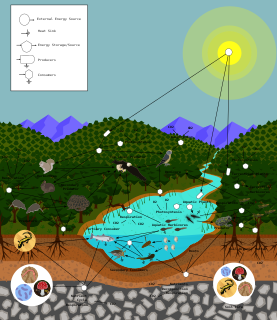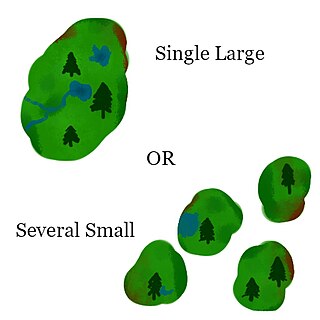This article needs additional citations for verification .(December 2019) |
Community assembly rules are a set of controversial rules in ecology, first proposed by Jared Diamond. [1]
This article needs additional citations for verification .(December 2019) |
Community assembly rules are a set of controversial rules in ecology, first proposed by Jared Diamond. [1]
The rules were developed after more than a decade of research into the avian assemblages on islands near New Guinea. The rules assert that competition is responsible for determining the patterns of assemblage composition.
The first rule is "forbidden species combinations". Diamond's hypothesis was that competition, not random immigration, was the main force structuring the species composition of islands.
So for example, the Bismarck black myzomela (Myzomela pammelaena) excludes the black sunbird (Nectarinia sericea). The Bismarck black myzomela lives on 23 of the 41 surveyed islands in the Bismarck Archipelago, but not on any of the 14 islands inhabited by the black sunbird. The two birds are about the same size, and both use their curved bills to sip nectar; Diamond argued that competition affects their distribution. [2]
Case tested the assembly rule that species occurring together on islands should have less niche overlap than random assemblages because they have undergone specialization. [3] His study measured niche overlap of lizards on 37 islands near Baja California and compared niche overlap to the median niche overlap of computer generated random species assemblages. Case found that 30 of the 37 islands had lower niche overlap than the random assemblages and that some of the competition is due to interspecific competition.
Testing the assembly rules is a complex process that often uses computer simulations to compare experimental data with characteristics of random assemblages of species. The rules are generally regarded as hypotheses that need to be tested on an individual basis, not as accepted conclusions. This is the reason why Diamond's results sparked nearly two decades worth of controversy in the literature, from the late seventies through the late nineties and is considered a turning point in community ecology. [4] Daniel Simberloff led the arguments against these rules claiming that theory as the one developed by Diamond "has generated predictions that are either practically untestable, by virtue of unmeasurable parameters or unrealizable assumptions, or trivially true". [4] The controversy was developed in a number of scientific papers (see for instance [5] and [6] ) and contributed to the development of null [7] and neutral models in community ecology, which are nowadays widely used to test the significance of ecological patterns. [8]

Theoretical ecology is the scientific discipline devoted to the study of ecological systems using theoretical methods such as simple conceptual models, mathematical models, computational simulations, and advanced data analysis. Effective models improve understanding of the natural world by revealing how the dynamics of species populations are often based on fundamental biological conditions and processes. Further, the field aims to unify a diverse range of empirical observations by assuming that common, mechanistic processes generate observable phenomena across species and ecological environments. Based on biologically realistic assumptions, theoretical ecologists are able to uncover novel, non-intuitive insights about natural processes. Theoretical results are often verified by empirical and observational studies, revealing the power of theoretical methods in both predicting and understanding the noisy, diverse biological world.

In ecology, a niche is the match of a species to a specific environmental condition. It describes how an organism or population responds to the distribution of resources and competitors and how it in turn alters those same factors. "The type and number of variables comprising the dimensions of an environmental niche vary from one species to another [and] the relative importance of particular environmental variables for a species may vary according to the geographic and biotic contexts".

In ecology, the competitive exclusion principle, sometimes referred to as Gause's law, is a proposition that two species which compete for the same limited resource cannot coexist at constant population values. When one species has even the slightest advantage over another, the one with the advantage will dominate in the long term. This leads either to the extinction of the weaker competitor or to an evolutionary or behavioral shift toward a different ecological niche. The principle has been paraphrased in the maxim "complete competitors can not coexist".
Insular biogeography or island biogeography is a field within biogeography that examines the factors that affect the species richness and diversification of isolated natural communities. The theory was originally developed to explain the pattern of the species–area relationship occurring in oceanic islands. Under either name it is now used in reference to any ecosystem that is isolated due to being surrounded by unlike ecosystems, and has been extended to mountain peaks, seamounts, oases, fragmented forests, and even natural habitats isolated by human land development. The field was started in the 1960s by the ecologists Robert H. MacArthur and E. O. Wilson, who coined the term island biogeography in their inaugural contribution to Princeton's Monograph in Population Biology series, which attempted to predict the number of species that would exist on a newly created island.
Ecology is a new science and considered as an important branch of biological science, having only become prominent during the second half of the 20th century. Ecological thought is derivative of established currents in philosophy, particularly from ethics and politics.

The SLOSS debate was a debate in ecology and conservation biology during the 1970's and 1980's as to whether a single large or several small (SLOSS) reserves were a superior means of conserving biodiversity in a fragmented habitat. Since its inception, multiple alternate theories have been proposed. There have been applications of the concept outside of the original context of habitat conservation.

Character displacement is the phenomenon where differences among similar species whose distributions overlap geographically are accentuated in regions where the species co-occur, but are minimized or lost where the species' distributions do not overlap. This pattern results from evolutionary change driven by biological competition among species for a limited resource. The rationale for character displacement stems from the competitive exclusion principle, also called Gause's Law, which contends that to coexist in a stable environment two competing species must differ in their respective ecological niche; without differentiation, one species will eliminate or exclude the other through competition.

Daniel Simberloff is a biologist and ecologist who earned his PhD from Harvard University in 1969. He is currently Gore Hunger Professor of Environmental Science at the University of Tennessee, editor-in-chief of the journal Biological Invasions and a member of the National Academy of Sciences
In ecology, niche differentiation refers to the process by which competing species use the environment differently in a way that helps them to coexist. The competitive exclusion principle states that if two species with identical niches compete, then one will inevitably drive the other to extinction. This rule also states that two species cannot occupy the same exact niche in a habitat and coexist together, at least in a stable manner. When two species differentiate their niches, they tend to compete less strongly, and are thus more likely to coexist. Species can differentiate their niches in many ways, such as by consuming different foods, or using different areas of the environment.

Species richness, or biodiversity, increases from the poles to the tropics for a wide variety of terrestrial and marine organisms, often referred to as the latitudinal diversity gradient (LDG). The LDG is one of the most widely recognized patterns in ecology. The LDG has been observed to varying degrees in Earth's past. A parallel trend has been found with elevation, though this is less well-studied.
The issue of what exactly defines a vacant niche, also known as empty niche, and whether they exist in ecosystems is controversial. The subject is intimately tied into a much broader debate on whether ecosystems can reach equilibrium, where they could theoretically become maximally saturated with species. Given that saturation is a measure of the number of species per resource axis per ecosystem, the question becomes: is it useful to define unused resource clusters as niche 'vacancies'?

Species use restricted ecological niches, and the niches of all species are segregated, often with much overlap, by the use of different habitats, different geographic areas and seasons, and different food resources, to mention only a few of the many niche dimensions. The causes of niche restriction and segregation are important problems in evolutionary ecology.

Interspecific competition, in ecology, is a form of competition in which individuals of different species compete for the same resources in an ecosystem. This can be contrasted with mutualism, a type of symbiosis. Competition between members of the same species is called intraspecific competition.

In ecology, a community is a group or association of populations of two or more different species occupying the same geographical area at the same time, also known as a biocoenosis, biotic community, biological community, ecological community, or life assemblage. The term community has a variety of uses. In its simplest form it refers to groups of organisms in a specific place or time, for example, "the fish community of Lake Ontario before industrialization".
A guild is any group of species that exploit the same resources, or that exploit different resources in related ways. It is not necessary that the species within a guild occupy the same, or even similar, ecological niches.
Mechanistic models for niche apportionment are biological models used to explain relative species abundance distributions. These niche apportionment models describe how species break up resource pool in multi-dimensional space, determining the distribution of abundances of individuals among species. The relative abundances of species are usually expressed as a Whittaker plot, or rank abundance plot, where species are ranked by number of individuals on the x-axis, plotted against the log relative abundance of each species on the y-axis. The relative abundance can be measured as the relative number of individuals within species or the relative biomass of individuals within species.
No-analog in paleoecology and ecological forecasting are those communities or climates that are compositionally different from a baseline for measurement of communities or climate, which is typically modern. Alternative naming conventions to describe no-analog communities and climates may include novel, emerging, mosaic, disharmonious and intermingled.
In ecology, a priority effect is an impact that a particular species can have on community development due to prior arrival at a site.
In ecological theory, the Hutchinson's ratio is the ratio of the size differences between similar species when they are living together as compared to when they are isolated. It is named after G. Evelyn Hutchinson who concluded that various key attributes in species varied according to the ratio of 1:1.1 to 1:1.4. The mean ratio 1.3 can be interpreted as the amount of separation necessary to obtain coexistence of species at the same trophic level.

Tolokiwa Island, also known as Lottin Island, is an island in the Bismarck Sea. The island is volcanic in origin and part of the Bismarck Archipelago.